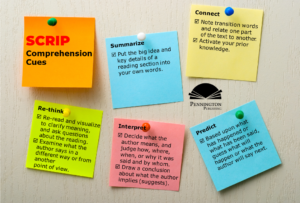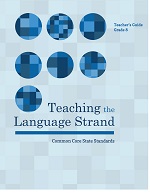Common Core Diagnostic ELA Assessments
As a teacher-publisher, I get quite a few questions about my products. It is heart-warming to see the recent re-kindled interest in assessment-based learning. Specifically, teachers want diagnostic assessments to determine which of the Common Core ELA/Literacy Standards their students do and do not know to be able to plan effective direct instruction and remediation in prior grade-level Standards. Teachers are particularly interested in diagnostic assessments for the grammar, usage, mechanics, spelling, and vocabulary Standards found in the Common Core Language Strand because of the level of instructional rigor required in these Standards. Here’s a set of questions from a potential customer on Teachers Pay Teachers re: my Common Core diagnostic ELA assessments. My answers should provide interested readers with the assessment-based resources they want to meet the needs of their students.
QUESTION: I notice that Pennington Publishing offers comprehensive whole-class diagnostic assessments with corresponding progress-monitoring matrices in grammar, usage, mechanics, and spelling for grades 4, 5, 6, 7, and 8. How many questions are on the tests, and how long do the tests take to administer? I teach sixth grade in a K−8 school. Are the diagnostic assessments different for each grade level? Also, if you don’t mind my asking… Why are you offering all of these assessments for only $3.00 if they are as good as you describe?
ANSWER: I’m happy to answer your questions. Even the last one. The grade 6 diagnostic grammar and usage assessment consists of 44 multiple choice questions and takes students about 25 minutes to complete.
The sixth grade mechanics assessment has 8 sentence answers with 32 discreet mechanics skills measured. (Students rewrite unpunctuated sentences.) The test takes about 15 minutes to complete.
The spelling assessment is comprehensive, not random samples as found in qualitative spelling inventories. It covers each of the sound-spellings students should know up to sixth grade. The assessment has 89 words to be dictated in the word, word-sentence-word format. I just gave the eighth grade spelling assessment to my own class. It has 102 words and it took 26 minutes to administer. We took a short stretch break half-way through. *Suggestion: Record the test on your phone and upload to your desktop, so you won’t have to re-dictate for test make-ups, new students, etc.
Yes, the grades 4, 5, 6, 7, and 8 diagnostic assessments are different for each grade level in that they build upon each other. The assessments are based upon the Common Core grade level Standards and the recommendations of the Common Core authors in Appendix A of the English Language Arts & Literacy in History/Social Studies, Science, and Technical Subjects. As you know, Appendix A includes the research base supporting the key elements of the Standards. So, the grade 8 assessment will have more assessment items than the grade 4 assessment.
Once teachers diagnose the specific deficits, e.g. you as a sixth grade teacher find out precisely which K-5 grammar, usage, mechanics, and spelling skills your students know and do not yet know, you and other teachers will want your students to master each of the relative deficits. Although veteran teachers will have some of the resources to remediate these deficits, most will not want to reinvent the wheel. So…
Pennington Publishing’s Grammar, Mechanics, Spelling, and Vocabulary grades 4, 5, 6, 7, and 8 programs have corresponding worksheets for each of the assessment items. The worksheets are fantastic with clear definitions, examples, practice, and a short formative assessment in which students apply what they have learned. Notice that these are not “drill and kill” worksheets teaching skills in isolation from the writing context. Answers included, of course. Plus, the Grammar, Mechanics, Spelling, and Vocabulary programs all provide direct instruction lessons for each of the grade-level grammar, usage, mechanics, spelling, vocabulary, and knowledge of language Common Core State Standards lessons with both print and digital teacher’s edition and accompanying consumable student workbooks. With the Grammar, Mechanics, Spelling, and Vocabulary program, students “catch up” while they “keep up” with the rigorous grade-level Common Core Standards.
These worksheets have been written by a teacher for teachers and their students with a built-in management system to keep students productive and to minimize teacher preparation and correction. Different students will be working on different worksheets to practice the concepts and skills each needs to remediate. The students self-correct their own worksheets from the answer booklets to be able to learn from their mistakes (and save the teacher time). Then students complete the WRITE formative assessment in which students are required to apply what they have learned re: the focused concept or skill in a sentence or two.
Once completed, the student visits the teacher for a 20-30-second mini-conference. The teacher skims the practice and corrections and reads the formative assessment. If mastered, the teacher (or student) marks that mastery on the progress monitoring matrices. Teachers, students, parents, (and, yes, principals) love to see that measurable progress on the matrices. It’s simple and effective individualized instruction with a built-in management system to maintain a productive and orderly learning experience.
Oh, by the way, teachers are licensed to place the worksheets on their class websites for parents and their children to access at home.
*****
What’s included in the value-priced Grammar, Mechanics, Spelling, and Vocabulary (Teaching the Language Strand) grades 4, 5, 6, 7, and 8 BUNDLES? These grade-level programs include both teacher’s guide and student workbooks and are designed to help you teach all the Common Core Anchor Standards for Language. In addition to the Teaching Grammar and Mechanics program, each BUNDLE provides weekly spelling pattern tests and accompanying spelling sort worksheets (L.2), 56 language application opener worksheets (L.3), and 56 vocabulary worksheets with multiple-meaning words, Greek and Latin word parts, figures of speech, word relationships with context clue practice, connotations, and four square academic language practice (L.4, 5, and 6). Comprehensive biweekly unit tests measure recognition, understanding, and application of the grammar, mechanics, and vocabulary components.
The program also has the resources to meet the needs of diverse learners. Diagnostic grammar, usage, mechanics, and spelling assessments provide the data to enable teachers to individualize instruction with targeted worksheets. Each remedial worksheet (over 200 per program) includes independent practice and a brief formative assessment.
Check out the brief introductory video and enter DISCOUNT CODE 3716 at check-out for 10% off this value-priced program. We do sell print versions of the teacher’s guide and student workbooks. Contact mark@penningtonpublishing.com for pricing. Read what teachers are saying about this comprehensive program:
The most comprehensive and easy to teach grammar, mechanics, spelling, and vocabulary program. I’m teaching all of the grade-level standards and remediating previous grade-level standards. The no-prep and minimal correction design of this program really respects a teacher’s time. At last, I’m teaching an integrated program–not a hodge-podge collection of DOL grammar, spelling and vocabulary lists, and assorted worksheets. I see measurable progress with both my grade-level and intervention students. BTW… I love the scripted lessons!
─Julie Villenueve










